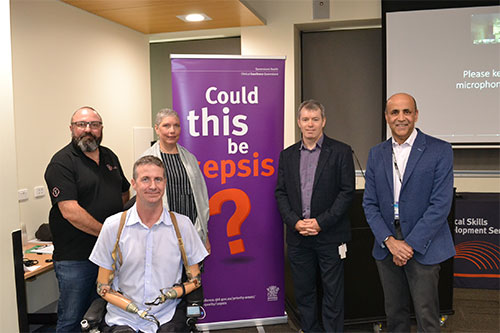The 'all teach, all learn' mentality of the Could this be sepsis? Breakthrough Collaborative continues to thrive, with the third learning session held in Brisbane last week.
Around 100 clinicians came together to share their progress in implementing and evaluating the adult and paediatric sepsis bundles, which are designed to enable clinicians to more reliably identify and escalate treatment for sepsis sooner.
Chair of the Queensland Sepsis Steering Committee, Professor Bala Venkatesh, said the two-day event was an invaluable learning opportunity. ‘The teams from across Queensland get to come together to share practical examples and discuss their experiences, and collectively workshop solutions and the best way forward.’
One of the practical solutions put forward came from Rockhampton Hospital, which is packaging blood culture request forms with the sepsis clinical pathway to prompt more reliable collection of two sets of blood cultures, which is known to better identify the organism causing an infection. This in turn helps target the most effective antibiotic treatment. The team also recently hosted a one-day sepsis seminar which was described by one staff member as a workshop they ‘would never forget’. The seminar attracted more than 80 staff—a record attendance for an education day demonstrating a keen interest in learning more about sepsis.
The Prince Charles Hospital is also seeing improvements, thanks in part to their ‘front-loading’ approach for paediatric patients. A Senior Medical Officer reviews unwell children at triage, which has reduced their time to screening for sepsis considerably. Paediatric patients treated in the resus area typically received antibiotics quicker, prompting the question that if they did the same method of parallel processing of tasks as they do in resus, they could see improvement across the board.
Paediatric Sepsis Clinical Co-Lead Associate Professor Luregn Schlapbach said whilst paediatric sepsis may be considered uncommon by some emergency departments, collectively across the state paediatric sepsis is a major problem. ‘For mixed emergency departments, specific strategies for paediatric patients become paramount because clinicians aren’t as familiar with sepsis in children because they don’t see many sick children. ‘But the clinical pathway is a cognitive aid that will help them, and the evidence around its use is clear.’
Many participating sites also had their executive sponsors present at the learning session. ‘The sponsors were able to hear directly about not only how well their hospital is doing, but also the overall importance of this program, particularly from our consumers’ perspective. Their stories are very powerful and remind us all about why we are here, and why we are doing this,’ Prof. Venkatesh said.

The power of collaboration and consumer engagement. Pictured (L-R) Damian Jones, Matthew Ames, Mary Steele (consumer representatives), with Michael Rice and Bala Venkatesh (Statewide Sepsis Steering Committee).
Adult and paediatric consumer representatives have played an active role from the inception of the sepsis program. Their involvement in the Could this be sepsis? program has been invaluable in generating ideas, raising awareness and motivating teams to improve outcomes for patients affected by sepsis. At the end of the consumer panel discussion, the representatives simply reiterated that behind the ‘numbers’ were people, and their stories.
For more information, visit the sepsis webpage or email the team at sepsis@health.qld.gov.au.
Keep up to date with Clinical Excellence Queensland:
- subscribe to our mailing list
- follow us on Twitter, Facebook or Instagram.